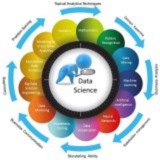Topic: Python SciPy – From Easy to Top: Part 4 of 6: Linear Algebra with SciPy
---
1. Introduction to Linear Algebra in SciPy
• Linear algebra is fundamental in scientific computing, machine learning, and data science.
• SciPy provides advanced linear algebra routines built on top of LAPACK and BLAS libraries.
• The main sub-package is
---
2. Basic Matrix Operations
You can create matrices using NumPy arrays:
---
3. Matrix Addition and Multiplication
---
4. Using `scipy.linalg` for Advanced Operations
Import SciPy linear algebra module:
---
5. Matrix Inverse
Calculate the inverse of a matrix (if invertible):
---
6. Determinant
Calculate the determinant:
---
7. Eigenvalues and Eigenvectors
Find eigenvalues and eigenvectors:
---
8. Solving Linear Systems
Solve
---
9. Singular Value Decomposition (SVD)
Decompose matrix A into U, Σ, and V^T:
---
10. LU Decomposition
Decompose matrix A into lower and upper triangular matrices:
---
11. QR Decomposition
Factorize A into Q and R matrices:
---
12. Norms of Vectors and Matrices
Calculate different norms:
---
13. Checking if a Matrix is Positive Definite
Try Cholesky decomposition:
---
14. Summary
• SciPy’s
• Operations include inverse, determinant, eigenvalues, decompositions, and solving linear systems.
• These tools are essential for many scientific and engineering problems.
---
Exercise
• Compute the eigenvalues and eigenvectors of the matrix \[\[4, 2], \[1, 3]].
• Solve the system of equations represented by:
2x + 3y = 8
5x + 4y = 13
• Perform SVD on the matrix \[\[1, 0], \[0, -1]] and explain the singular values.
---
#Python #SciPy #LinearAlgebra #SVD #Decomposition #ScientificComputing
https://t.iss.one/DataScienceM
---
1. Introduction to Linear Algebra in SciPy
• Linear algebra is fundamental in scientific computing, machine learning, and data science.
• SciPy provides advanced linear algebra routines built on top of LAPACK and BLAS libraries.
• The main sub-package is
scipy.linalg which extends NumPy’s linear algebra capabilities.---
2. Basic Matrix Operations
You can create matrices using NumPy arrays:
import numpy as np
A = np.array([[1, 2], [3, 4]])
B = np.array([[5, 6], [7, 8]])
---
3. Matrix Addition and Multiplication
# Addition
C = A + B
print("Matrix Addition:\n", C)
# Element-wise Multiplication
D = A * B
print("Element-wise Multiplication:\n", D)
# Matrix Multiplication
E = np.dot(A, B)
print("Matrix Multiplication:\n", E)
---
4. Using `scipy.linalg` for Advanced Operations
Import SciPy linear algebra module:
from scipy import linalg
---
5. Matrix Inverse
Calculate the inverse of a matrix (if invertible):
inv_A = linalg.inv(A)
print("Inverse of A:\n", inv_A)
---
6. Determinant
Calculate the determinant:
det_A = linalg.det(A)
print("Determinant of A:", det_A)
---
7. Eigenvalues and Eigenvectors
Find eigenvalues and eigenvectors:
eigvals, eigvecs = linalg.eig(A)
print("Eigenvalues:\n", eigvals)
print("Eigenvectors:\n", eigvecs)
---
8. Solving Linear Systems
Solve
Ax = b where b is a vector:b = np.array([5, 11])
x = linalg.solve(A, b)
print("Solution x:\n", x)
---
9. Singular Value Decomposition (SVD)
Decompose matrix A into U, Σ, and V^T:
U, s, VT = linalg.svd(A)
print("U matrix:\n", U)
print("Singular values:", s)
print("V^T matrix:\n", VT)
---
10. LU Decomposition
Decompose matrix A into lower and upper triangular matrices:
P, L, U = linalg.lu(A)
print("P matrix:\n", P)
print("L matrix:\n", L)
print("U matrix:\n", U)
---
11. QR Decomposition
Factorize A into Q and R matrices:
Q, R = linalg.qr(A)
print("Q matrix:\n", Q)
print("R matrix:\n", R)
---
12. Norms of Vectors and Matrices
Calculate different norms:
# Vector norm
v = np.array([1, -2, 3])
norm_v = linalg.norm(v)
print("Vector norm:", norm_v)
# Matrix norm (Frobenius norm)
norm_A = linalg.norm(A, 'fro')
print("Matrix Frobenius norm:", norm_A)
---
13. Checking if a Matrix is Positive Definite
Try Cholesky decomposition:
try:
L = linalg.cholesky(A)
print("Matrix is positive definite")
except linalg.LinAlgError:
print("Matrix is not positive definite")
---
14. Summary
• SciPy’s
linalg module provides extensive linear algebra tools beyond NumPy.• Operations include inverse, determinant, eigenvalues, decompositions, and solving linear systems.
• These tools are essential for many scientific and engineering problems.
---
Exercise
• Compute the eigenvalues and eigenvectors of the matrix \[\[4, 2], \[1, 3]].
• Solve the system of equations represented by:
2x + 3y = 8
5x + 4y = 13
• Perform SVD on the matrix \[\[1, 0], \[0, -1]] and explain the singular values.
---
#Python #SciPy #LinearAlgebra #SVD #Decomposition #ScientificComputing
https://t.iss.one/DataScienceM
❤8
